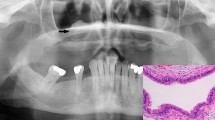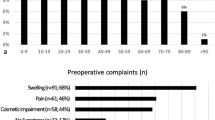Abstract
Purpose
Langerhans cell histiocytosis (LCH) is a rare neoplasm and has heterogeneous clinical presentation and behavior. We analyzed solitary lytic lesions of the skull and spine in pediatric and adult patients.
Methods
Between 2001 and 2011, 42 patients underwent surgery for LCH. Skull and/or spine involvement were evident in 21 (63.6 %) of the 33 pediatric patients and 8 (88.9 %) of the 9 adults. The 21 pediatric patients showed the unifocal monosystemic lesions in 10, multifocal monosystemic in 4, and multisystemic in 7. The eight adults comprised seven unifocal lesions and one multifocal monosystemic lesion. Of these cases, we analyzed the clinical courses of solitary LCH of skull and spine in 10 pediatric patients and 7 adults.
Results
The median age was 10.1 years (range: 1.1–14.1) in pediatric patients and 34.6 years (range: 26.1–52.0) in adults. The median follow-up was 3.1 years (range: 0.6–9.5). Total excision was done in 15 patients and biopsy in 2. Postoperative adjuvant chemotherapy was done in four pediatric patients and one adult, and comprised mass with dural adhesion (N = 2), skull base lesion (N = 1), atlas mass (N = 1), and vertebral lesion with soft tissue extension (N = 1). During follow-up, recurrence occurred in one pediatric patient who had a skull LCH with a dural adhesion. The patient experienced central diabetes insipidus and scapular pain due to pituitary stalk and scapula involvement 1.3 and 2.4 years later, respectively.
Conclusion
Even if the solitary lesions of skull and spine show a favorable clinical course, some patients could show aggressive behavior.

Similar content being viewed by others
References
Arkader A, Glotzbecker M, Hosalkar HS, Dormans JP (2009) Primary musculoskeletal Langerhans cell histiocytosis in children: an analysis for a 3-decade period. J Pediatr Orthop 29:201–207
Rawlings CE 3rd, Wilkins RH (1984) Solitary eosinophilic granuloma of the skull. Neurosurgery 15:155–161
Martinez-Lage JF, Poza M, Cartagena J, Vicente JP, Biec F, DelasHeras M (1991) Solitary eosinophilic granuloma of the pediatric skull and spine. The role of surgery. Childs Nerv Syst 7:448–451
Leonidas JC, Guelfguat M, Valderrama E (2003) Langerhans cell histiocytosis. Lancet 361:1293–1295
Grois NG, Favara BE, Mostbeck GH, Prayer D (1998) Central nervous system disease in Langerhans cell histiocytosis. Hematol Oncol Clin North Am 12:287–305
Komp DM, Herson J, Starling KA, Vietti TJ, Hvizdala E (1981) A staging system for histiocytosis X: a Southwest Oncology Group Study. Cancer 47:798–800
Andreacchio A, Brach del Prever A, Linari A, Postini AM, Defilippi C, Berta M (2008) Eosinophilic granuloma of the bone: a diagnostic issue. J Child Orthop 2(Suppl 1):S32–S33
Bruno MC, Del Basso De Caro ML, Panagiotopoulos K, Elefante A, Tortora F, De Notaris MG, Colella A, Ginguene C, Cerillo A (2006) Aggressive eosinophilic granuloma of the parietal bone. An immunohistochemical study of Ki-67 expression. J Neurosurg Sci 50:111–117
Brisman JL, Feldstein NA, Tarbell NJ, Cohen D, Cargan AL, Haddad J Jr, Bruce JN (1997) Eosinophilic granuloma of the clivus: case report, follow-up of two previously reported cases, and review of the literature on cranial base eosinophilic granuloma. Neurosurgery 41:273–278, discussion 278–279
Stull MA, Kransdorf MJ, Devaney KO (1992) Langerhans cell histiocytosis of bone. Radiographics 12(4):801–823
Postini AM, Andreacchio A, Boffano M, Pagano M, Brach Del Prever A, Fagioli F (2012) Langerhans cell histiocytosis of bone in children: a long-term retrospective study. J Pediatr Orthop B 21:457–462
Mut M, Cataltepe O, Bakar B, Cila A, Akalan N (2004) Eosinophilic granuloma of the skull associated with epidural haematoma: a case report and review of the literature. Childs Nerv Syst 20:765–769
Okamoto K, Ito J, Furusawa T, Sakai K, Tokiguchi S (1999) Imaging of calvarial eosinophil granuloma. Neuroradiology 41:723–728
Cho DY, Liau WR, Chiang IP (2001) Eosinophilic granuloma with acute epidural hematoma: a case report. Pediatr Neurosurg 35:266–269
Martinez-Lage JF, Bermudez M, Martinez-Barba E, Fuster JL, Poza M (2002) Epidural hematoma from a cranial eosinophilic granuloma. Childs Nerv Syst 18:74–76
Allen CE, McClain KL (2007) Langerhans cell histiocytosis: a review of past, current and future therapies. Drugs Today (Barc) 43:627–643
Oliveira M, Steinbok P, Wu J, Heran N, Cochrane D (2003) Spontaneous resolution of calvarial eosinophilic granuloma in children. Pediatr Neurosurg 38:247–252
Boutsen Y, Esselinckx W, Delos M, Nisolle JF (1999) Adult onset of multifocal eosinophilic granuloma of bone: a long-term follow-up with evaluation of various treatment options and spontaneous healing. Clin Rheumatol 18:69–73
Baker GS, Fisher RG (1948) Eosinophilic granuloma of the skull; report of four cases, with 5-year follow-up. Surg Clin N Am 28:1057–1070
Bynum GA (1952) Eosinophilic granuloma of the skull, report of six cases. Am Surg 18:793–805
Puzzilli F, Mastronardi L, Farah JO, Ruggeri A, Lunardi P (1998) Solitary eosinophilic granuloma of the calvaria. Tumori 84:712–716
Grois N, Potschger U, Prosch H, Minkov M, Arico M, Braier J, Henter JI, Janka-Schaub G, Ladisch S, Ritter J, Steiner M, Unger E, Gadner H (2006) Risk factors for diabetes insipidus in Langerhans cell histiocytosis. Pediatr Blood Cancer 46:228–233
Author information
Authors and Affiliations
Corresponding author
Rights and permissions
About this article
Cite this article
Lee, SK., Jung, TY., Jung, S. et al. Solitary Langerhans cell histocytosis of skull and spine in pediatric and adult patients. Childs Nerv Syst 30, 271–275 (2014). https://doi.org/10.1007/s00381-013-2198-1
Received:
Accepted:
Published:
Issue Date:
DOI: https://doi.org/10.1007/s00381-013-2198-1




